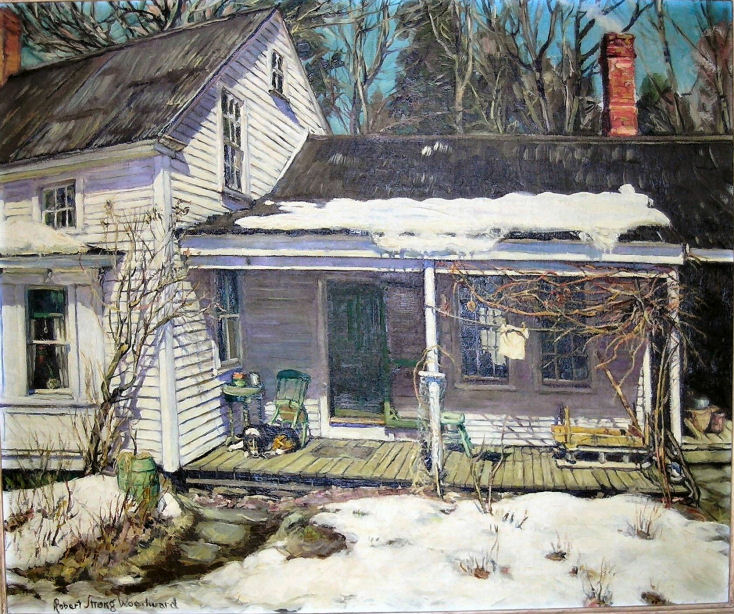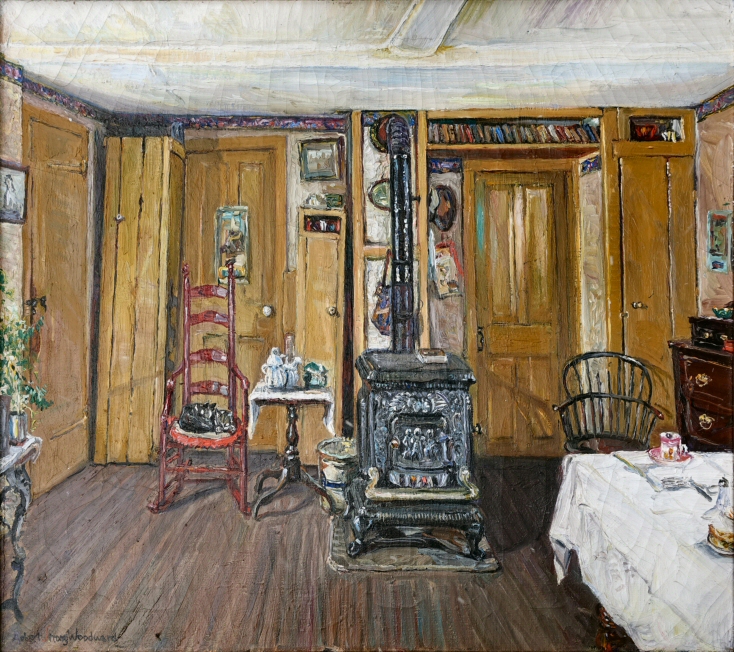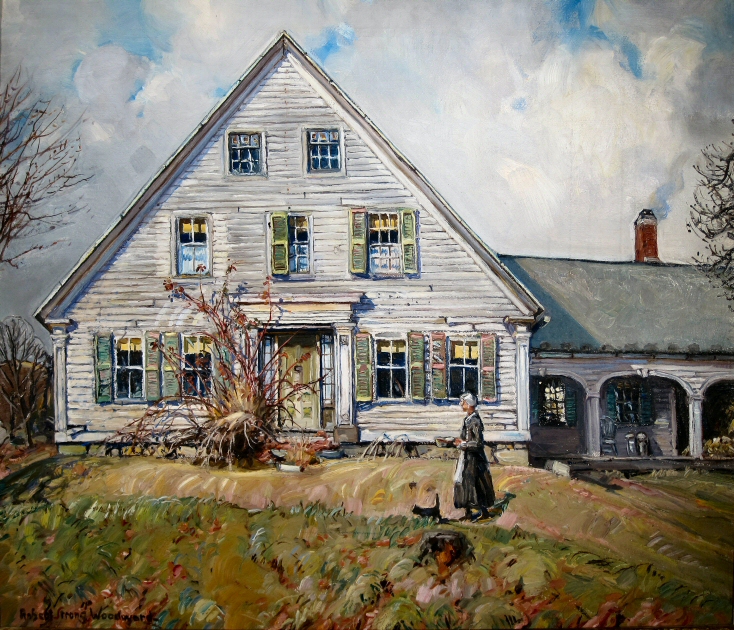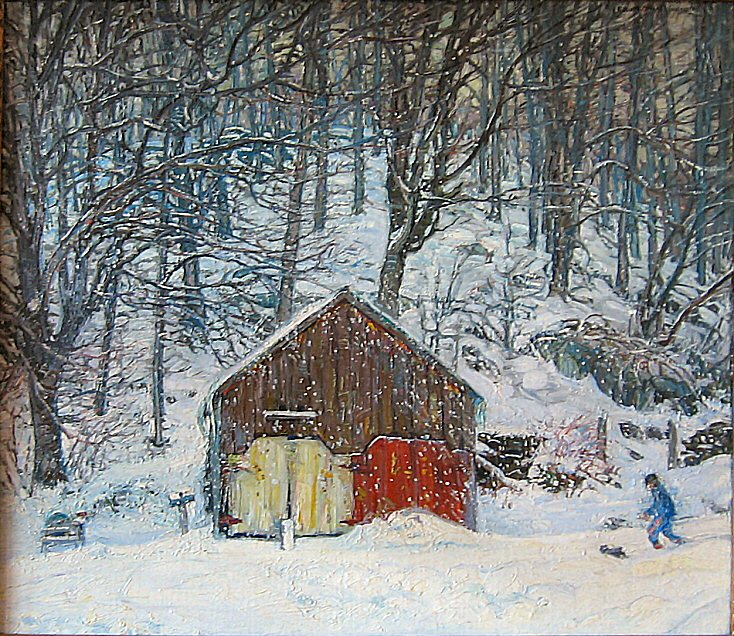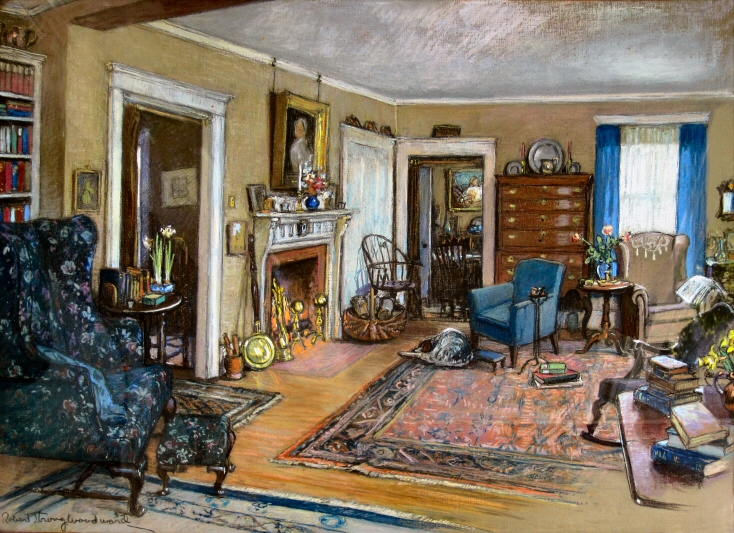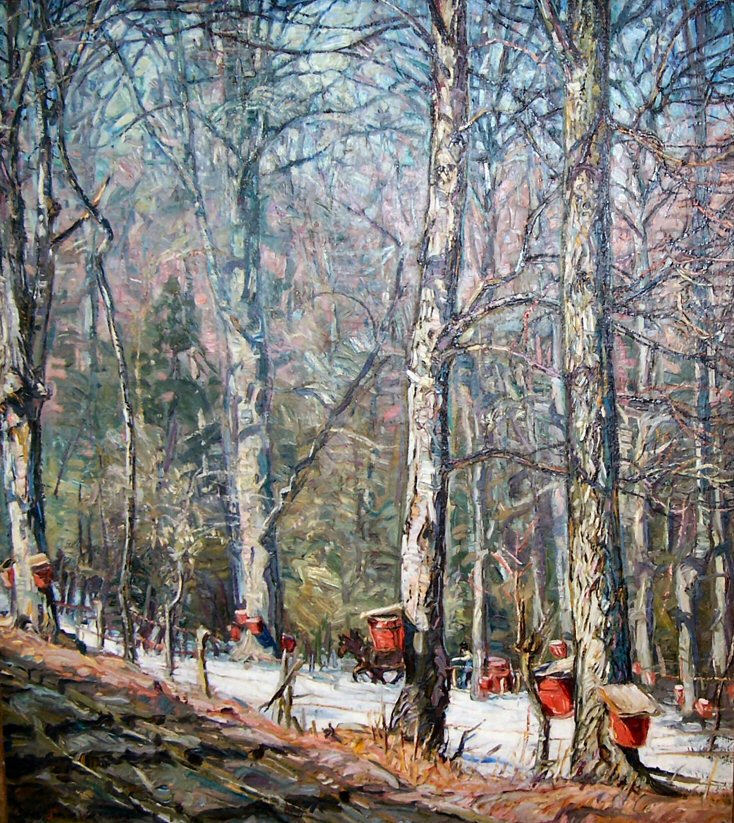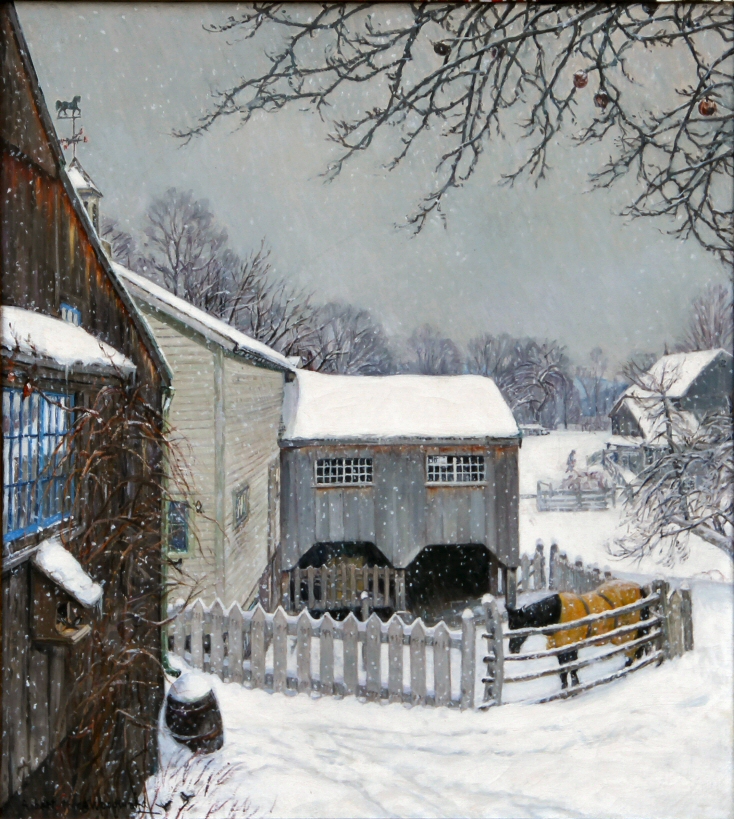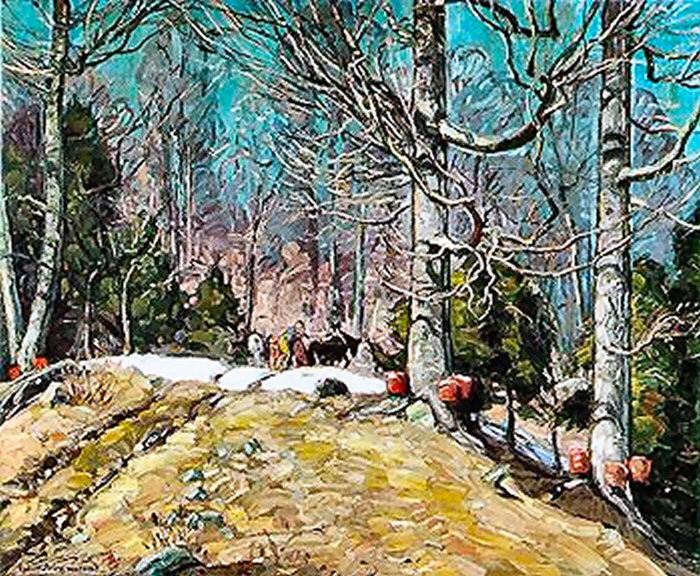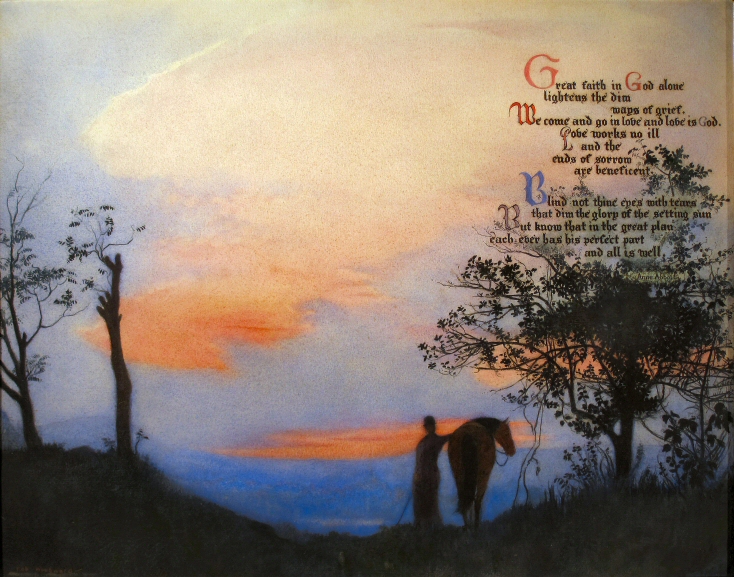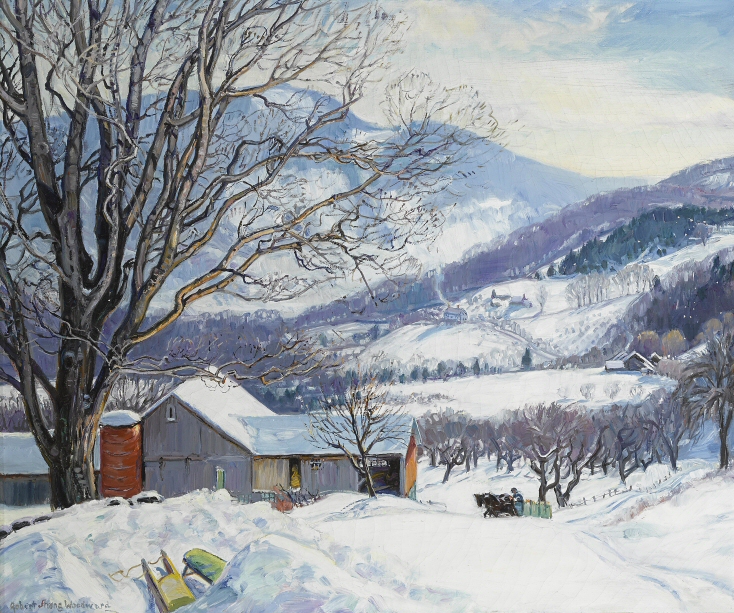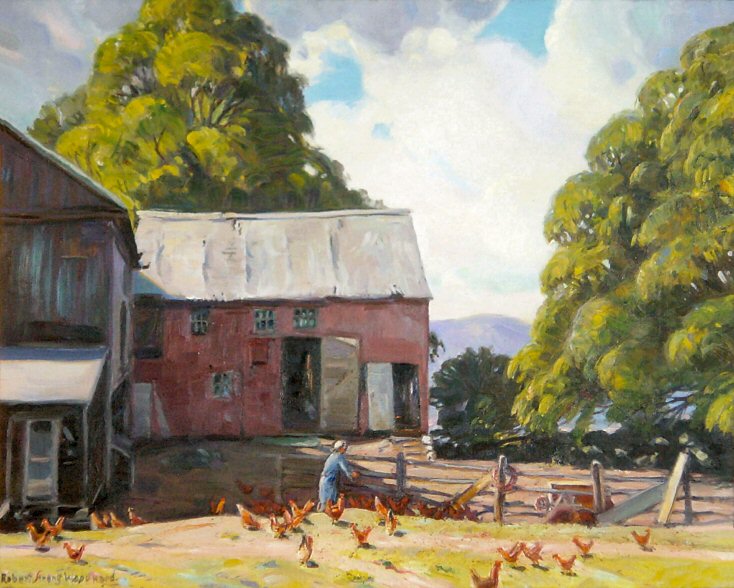Woodward's Horses and Pets
A revised update of Dr. Mark's original page last revised in July of 2013
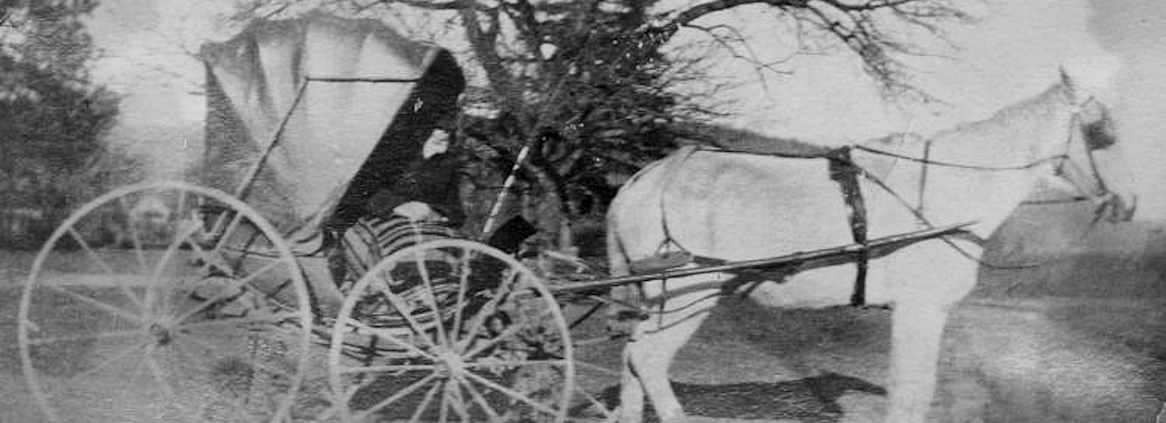
Woodward's first horse in Massachusetts. The horse's name is unknown to us and as far as we know the only white horse RSW owned.
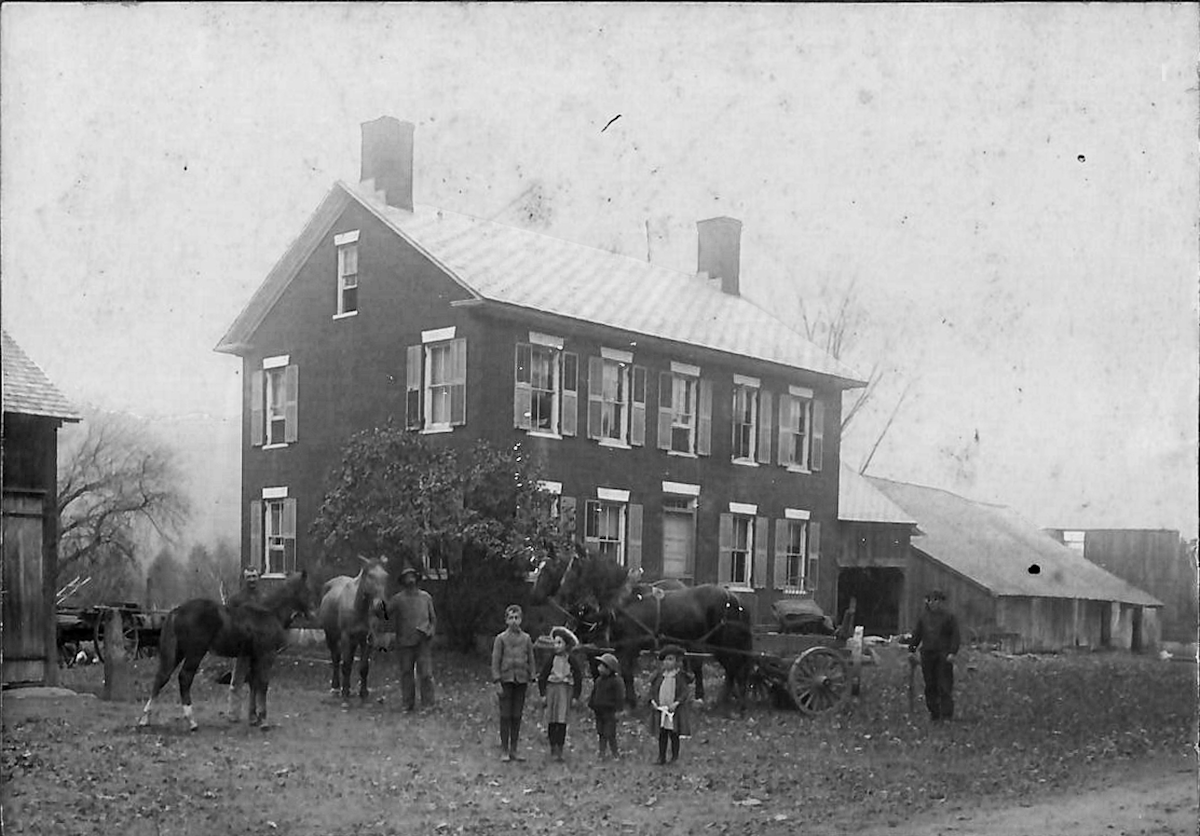
 A 1905 photograph of the Well's Pine Brook Farm. The fourkids in the center are RSW's cousins (l-r) Nelson, Florence,Julia, and Alta. We cannot identified the men, though we thinkthe man on the far left, behind the horse, is their father Bert
A 1905 photograph of the Well's Pine Brook Farm. The fourkids in the center are RSW's cousins (l-r) Nelson, Florence,Julia, and Alta. We cannot identified the men, though we thinkthe man on the far left, behind the horse, is their father Bert
Wells. To the left of him, you can see the corner of the dairy
shed which will later become RSW's Redgate studio. Also, note
the garage-like structure just to the right of the brick house?
It will be converted into RSW's residence, named the Annex.
HORSES: THE EARLY YEARS
From the very first days of the paralyzed Robert Strong Woodward's arrival back in Buckland in 1911 he owned a horse. The name of the first horse housed in the Bert Wells' barn behind Redgate has been lost to history. We have not been able to learn anything about this horse except for finding one old yellowing photograph (above) of him/her harnessed up to travel on the grounds of Redgate. She was a white horse and as far as we know the first one to carry RSW into the countryside to produce his famous en plein air paintings of the New England countryside.
Robert Strong Woodward's second known horse was a mare named Tsune. RSW was an ardent admirer of Japanese art and culture. He had many books of Japanese prints and paintings on the shelves of all of his studios. Other than that possible connection, little is known about how Tsune was attained. On the back of one of our photographs is written in RSW's handwriting: "Tsune... this is a Japanese name." Another comment: "Note her long tail." Thus we learned that Tsune was a girl horse. When a woodstove fire destroyed Redgate in 1922, she moved up to the Hiram Woodward Barn. (See image below.)
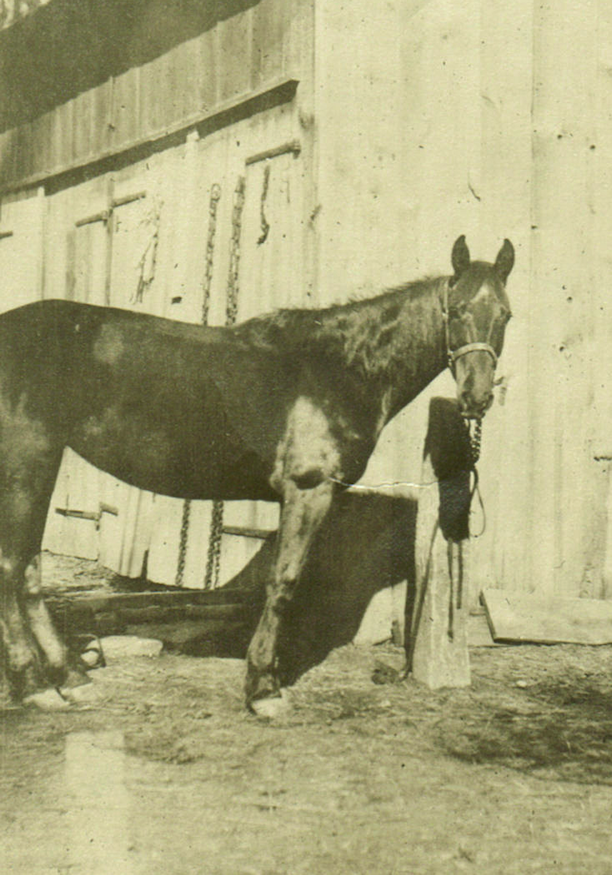
 Top, Tsune hitched by the barn at Hiram
Top, Tsune hitched by the barn at Hiram
Below are the different characters. The
character on the right is the one used
by Dr. Mark on the original page.
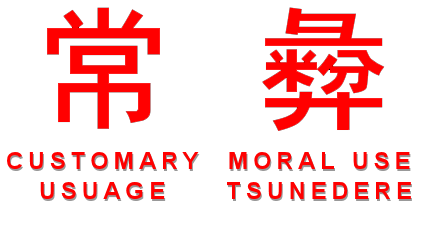
A Google search reveals the Japanese character for Tsune to be the one shown here. One reading or interpretation of this is: "to look at one with disgust and then develop into a lovey-dovey relationship." This must have been the personality character of Tsune.
ADDENDUM TO THE NAME TSUNE:
When this page was first published in July of 2013, Dr. Mark's research on the name Tsune was quite close.
This issue, and this took a great deal more investigation, is that the Japanese language and linguistical etimology is really quite complicated. Tsune's ( pronounced soo-ney ) origins are from the kanji system of writing
using Chinese characters. Kanji are the adopted logographic Chinese characters that are used in the Japanese writing system. They are used alongside the Japanese syllabic scripts hiragana and katakana.
Typically each kanji represents a large philosophical concept or sentiment and the hiragana and/or katakana specifies its context.
What Dr. Mark referenced as the meaning of Tsune is in fact true
but incomplete. The actual Japanese word for what Dr. Mark decribes is "Tsunedere." It is a commonly used plot device in Japanese Amine stories in which the customary conduct of when a boy meets girl. Japanese
morals require she feign disgust initially. It is most commonly used today as an adverb meaning "ever."
However, as a noun, like a name, it means "always" but not in the sense of eternity (outside
of time) but rather sempiternal (within time and towards the future). It means constant or persevering if you will... If interested for more, see Brian's sidebar essay on the term as how it may relate to Woodward's choice
to name his horse Tsune and the name's realtionship to Thomas à Kempis. SIDEBAR ESSAY: Tsune put into Context
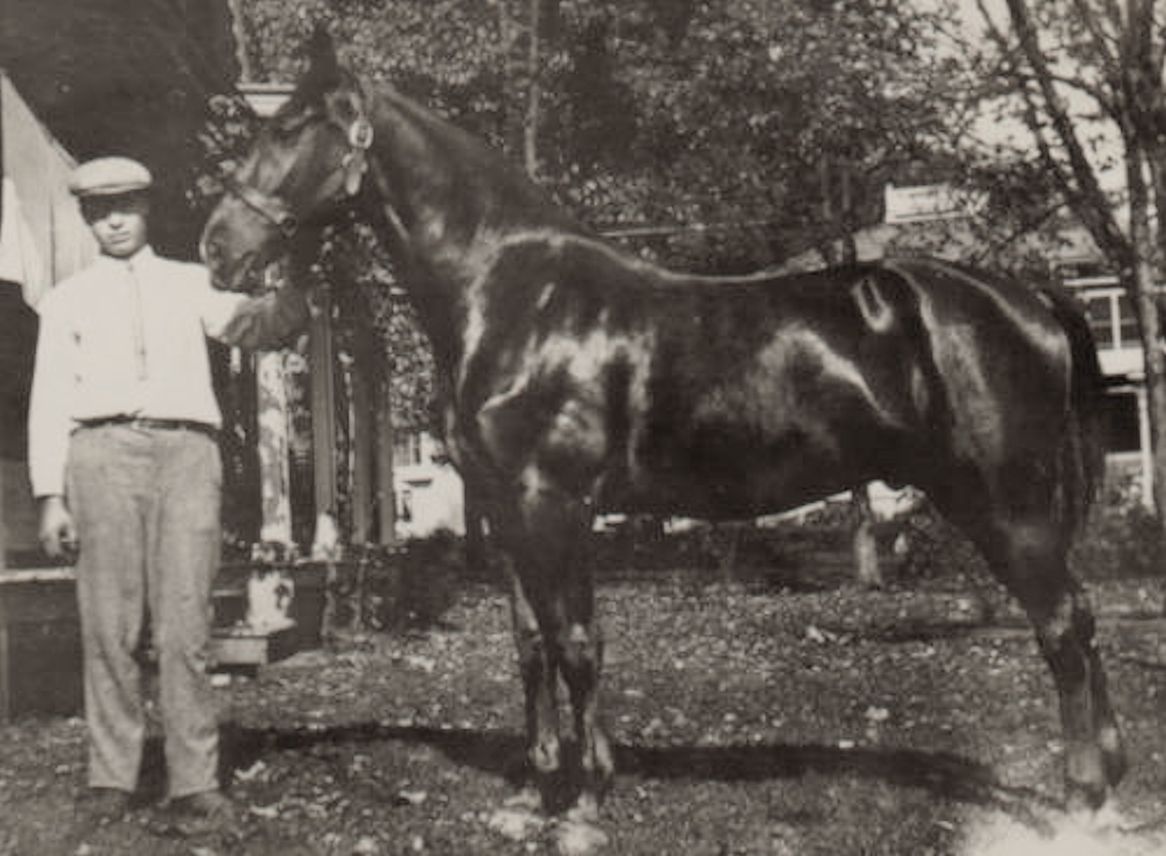
 Thomas à Kempis being held for a photograph. The
Thomas à Kempis being held for a photograph. The
location or the man holding him are unknown. There does appear
to be a family resemblence. It could be RSW's cousin Nelson
WOODWARD'S PRIDE: Thomas à Kempis
RSW's third horse was named Thomas à Kempis. It would seem from the old photographs and mentions of his horses in letters and on
postcards, that Tsune and Thomas à Kempis were, for a while at least, contemporary, both living at Redgate and then both moving up to the Hiram Woodward Barn.
For most of the Hiram Woodward
era, however, Thomas à Kempis was the Horse of the Barnyard. He carried RSW around all of the local country roads and his picture appeared in numerous newspaper and magazine articles about Robert Strong
Woodward. There were frequent direct mentions of his name and of his contributions to the art of this painter of New England scenes.
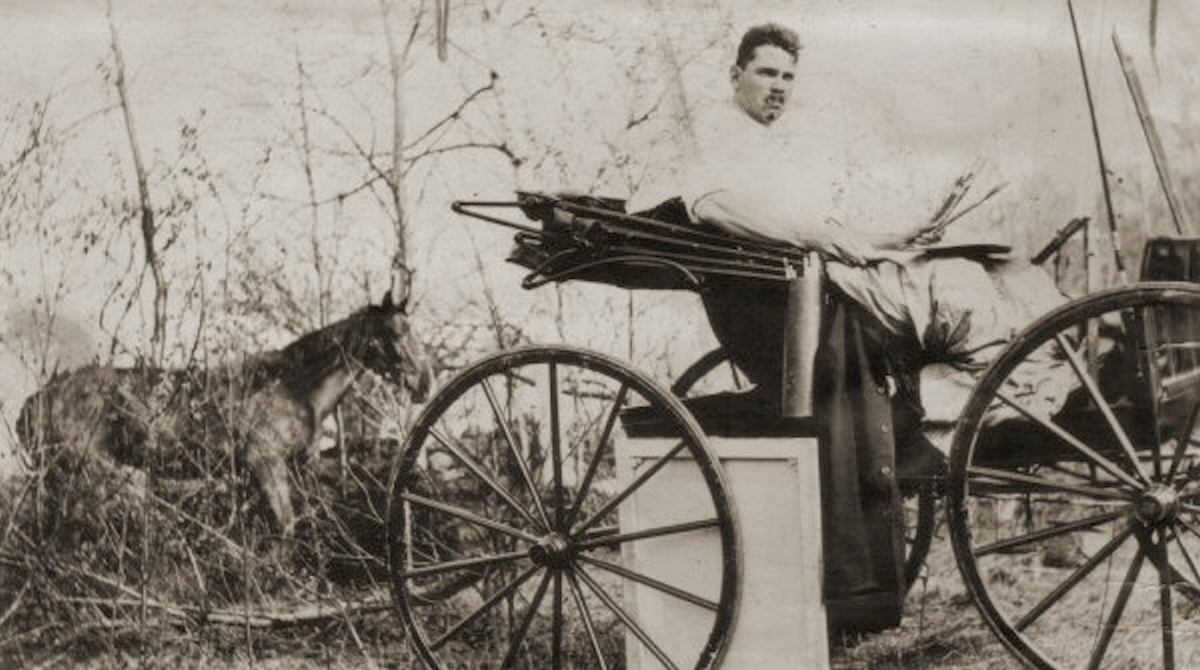
 Woodward and Thomas à Kempis in the field around 1919 - '20. This photo
Woodward and Thomas à Kempis in the field around 1919 - '20. This photo
appeared in the
December 8, 1920 Boston Evening Transcript profile featuring RSW.
How he got his name is unknown. Thomas à Kempis, in the human world, was a Franciscan monk of the 15th century
famous for being the author of "The Imitation of Christ. The Imitation is perhaps the most widely read Christian devotional work next to the Bible, and is regarded as a devotional and religious classic." [Quote from Wikipedia] (For more see Sidebar)
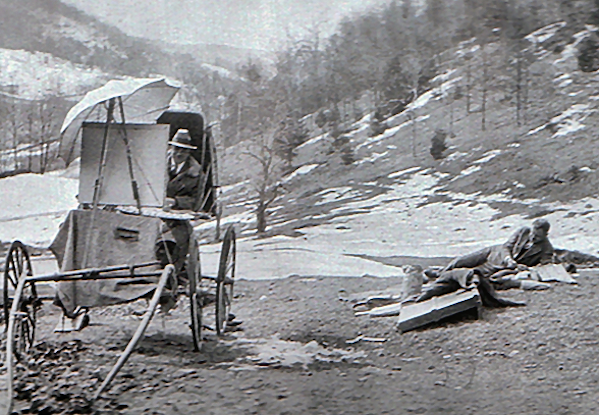
 RSW in buggy painting with attendent in the field
RSW in buggy painting with attendent in the field
When a fire destroyed the first studio, Redgate, Thomas à Kempis went with RSW up to the Hiram Woodward studio and continued to serve the artist for many years, by pulling his sleighs and buggies around the
country roads. By this time in his career RSW had a personal attendant who would often accompany him on trips, and care for the horse during the daytime, while RSW painted seated in the buggy.
Thomas à Kempis is recorded in many of the old photographs of that era. Woodward was able to mount and ride him without assistance. He was able also to hitch him up to a buggy and travel off to quite distant places to paint (even as far as Heath, some 15 miles away) spend a day painting and return to the Hiram Woodward place in time for supper. Also, it was during this period that Thomas à Kempis had to play "second fiddle" because some of the en plein air trips would be made in the new automobile with Woodward seated in the rear seat to paint for the day.
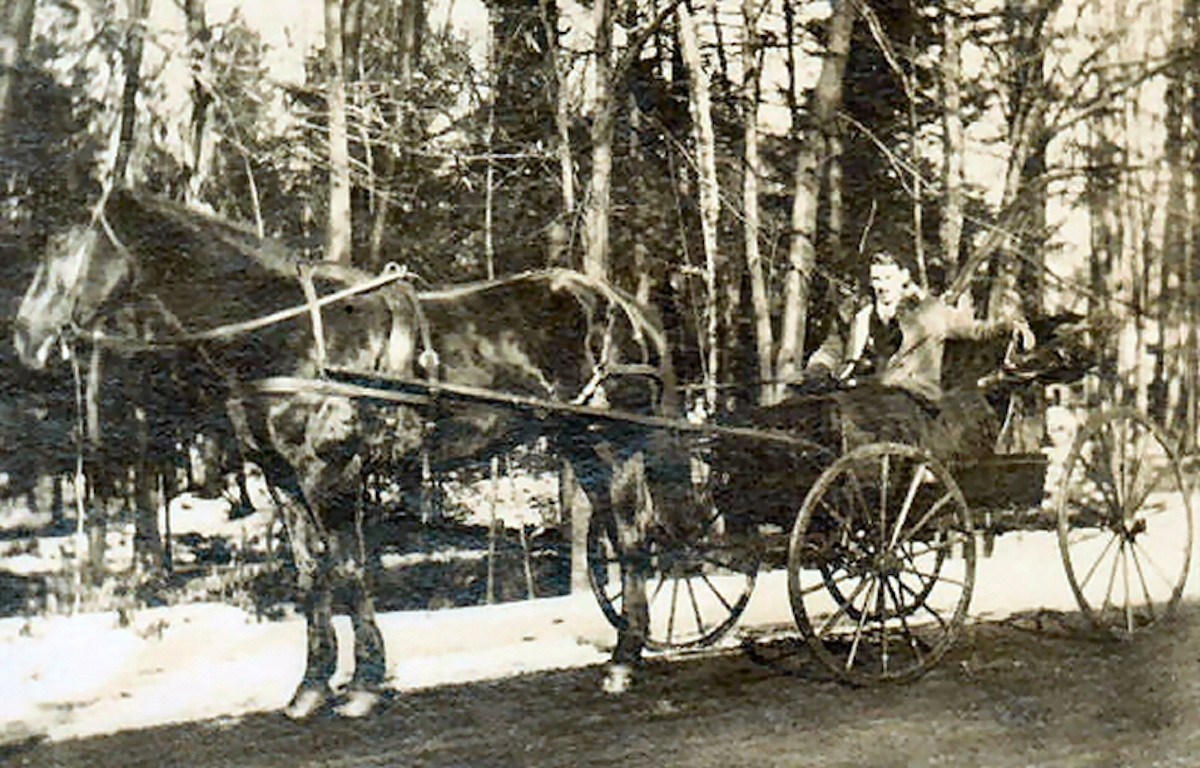
 RSW in his buggy being pulled by Thomas à Kempis.
RSW in his buggy being pulled by Thomas à Kempis.
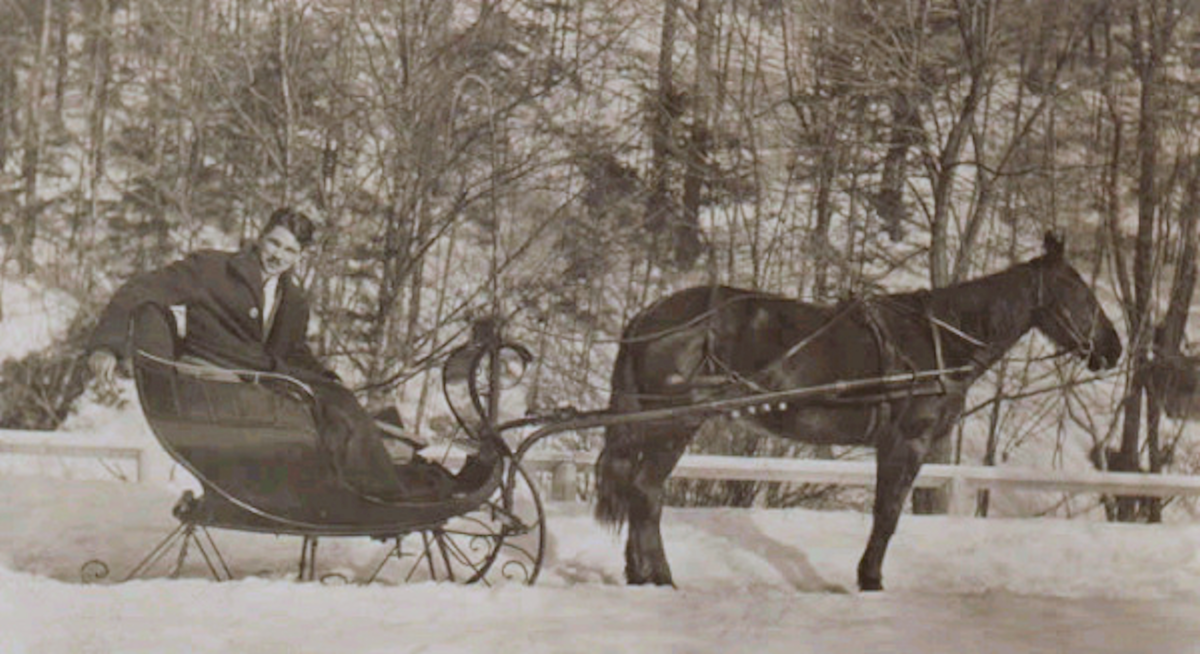
 Thomas à Kempis pulling RSW in an
Albany Cutter sleigh. In a 1920
Thomas à Kempis pulling RSW in an
Albany Cutter sleigh. In a 1920
featured article profiling Woodward for the Boston Evening Transcript.
The profile gives us the first
account that he first set out to paint professional-
ly was from a sleigh in April of 1917, presumedly with Thomas à Kempis.
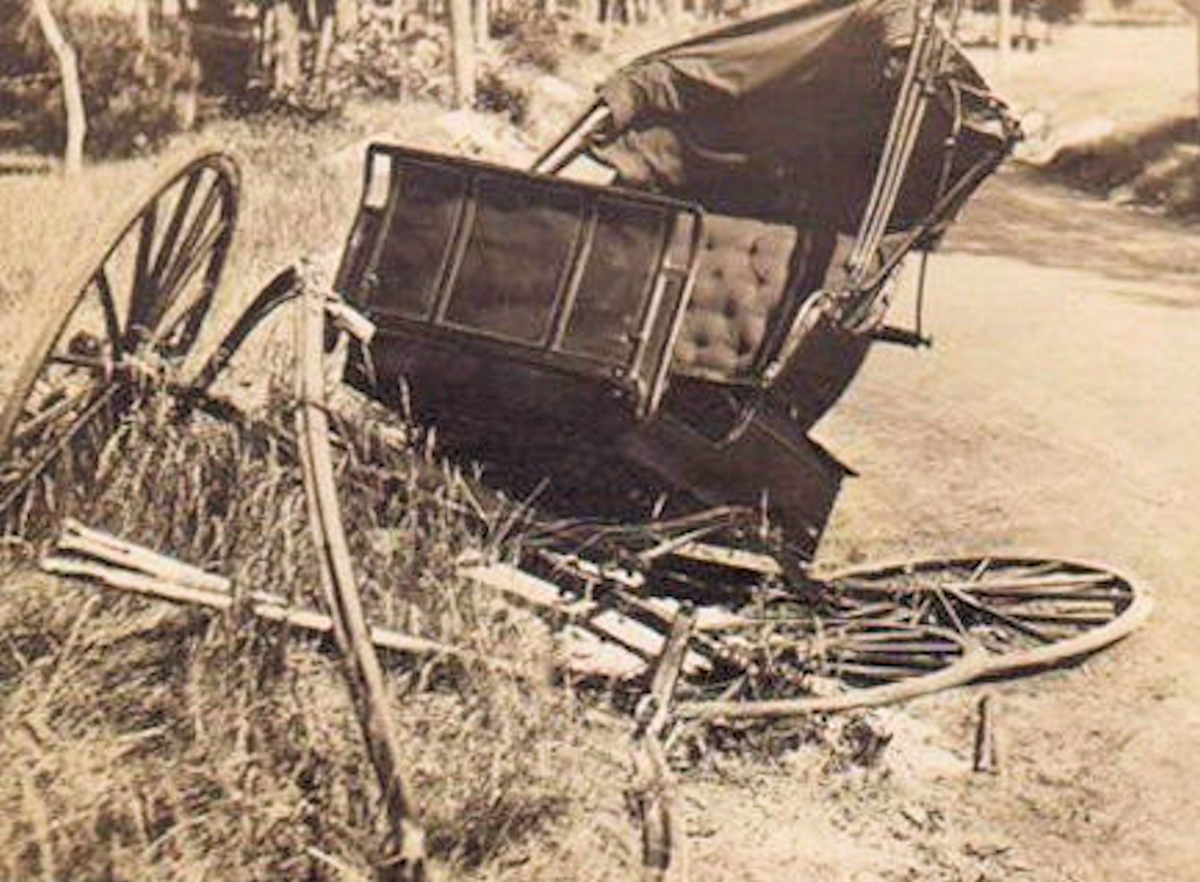
 A photo of a wrecked buggy from May 22, 1922.
A photo of a wrecked buggy from May 22, 1922.
Found in a collection of photos saved by RSW in his
items. We have recently learned RSW and his friend Julia
White were involved in a hit-and-run accident. We believe
Thomas à Kempis was pulling the buggy. No one was serious-
ly injured. For more see: CAR TROUBLES & OTHER MISHAPS
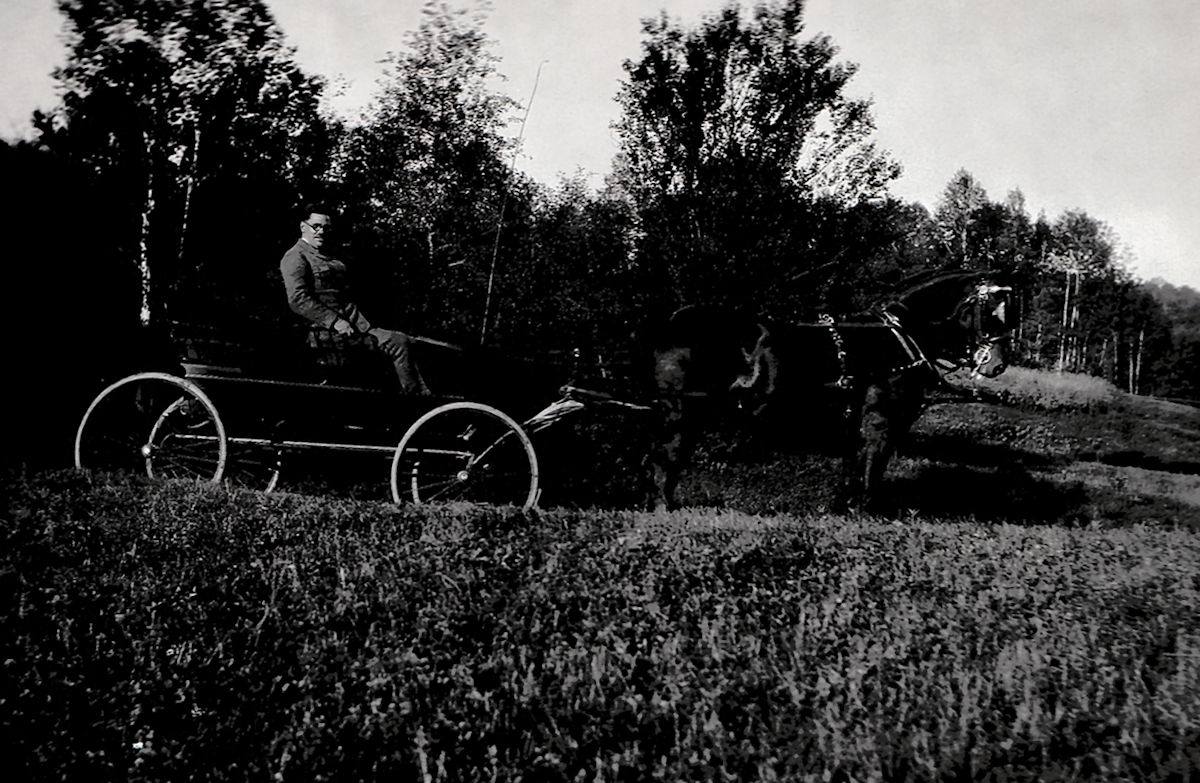
 Recently discovered in a pile of negatives from RSW's personal items is this
Recently discovered in a pile of negatives from RSW's personal items is this
picture of RSW on a two-horse drawn buckboard
carriage. There is a story told
by RSW's Boston art dealer Morton Vose involving this carriage that until now
was doubted. Without any other evidence, we believe, the two-horse
team to be
Tsune and Thomas à Kempis. For more see: CAR TROUBLES & OTHER MISHAPS
By 1922 or '24, RSW had an automobile, a Studebaker Light Six Roadster. It was not uncommon for an attendant to follow the buggy, in the automobile, to where the painting was to be made, unharness Thomas à Kempis, tie him to a nearby tree, then go back home until later in the day when he would return to reharness him for the return trip to the Hiram Woodward Studio. From his 1932 diary,
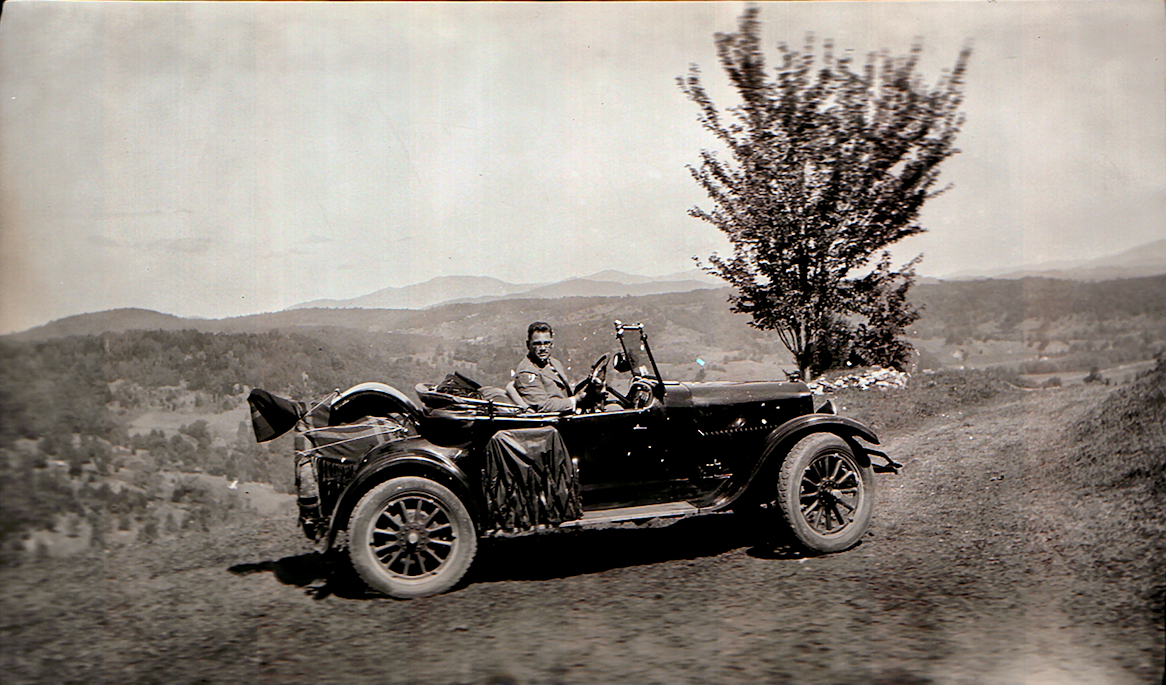
Top & below: Either a 1922 or '24 Studebaker Light Six Roadster
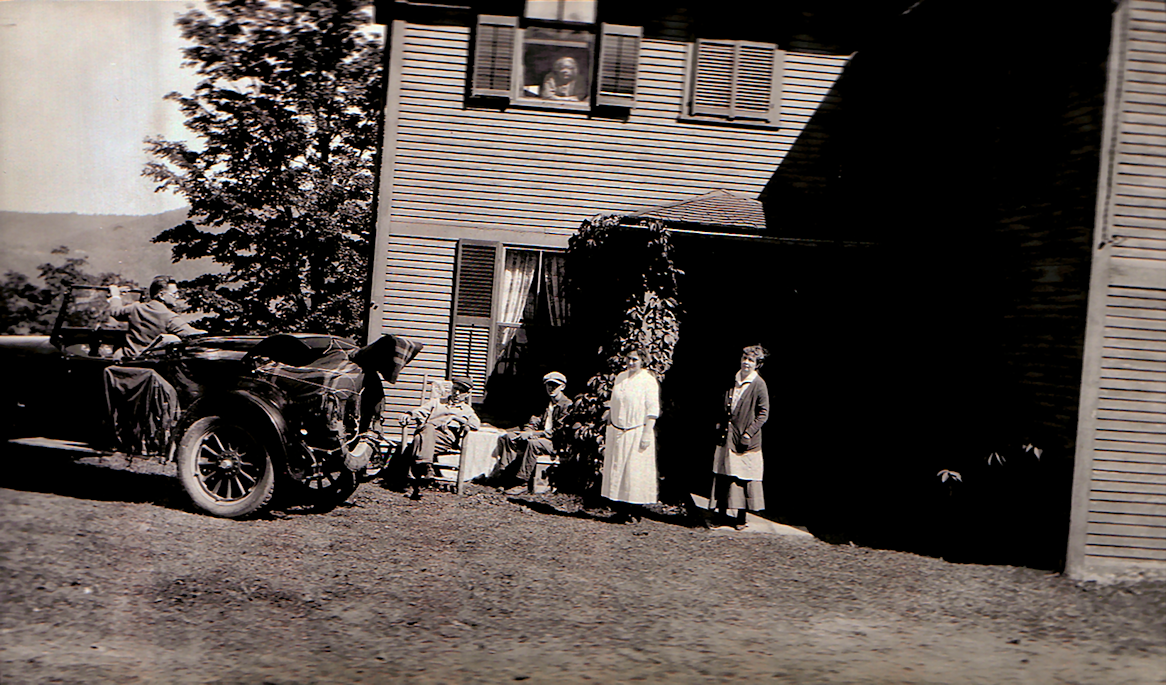
Bottom: May 5, 1916, Springfield Republican clipping

August 8
"Had Henry drive to Moors with horse, followed in car and painted there all day in the buggy. Car went back to take Mrs. Cowles to Greenfield to Dr. Bryant. Drove home with horse."
ADDENDUMS TO THE THOMAS À KEMPIS SECTION:
 New evidence over the past several years suggest
that Woodward never lived in Redgate. He may have slept there from time to time but living relatives of his have confirmed he resided elsewhere. He moved to his Aunt
and Uncle Tella and Bert Well's Farm in November or December of 1910. The family coverted a carriage house (seen in 1905 photo above) into a residence they called the Annex. They also added a ramp to
the front porch (added sometime between 1905 and 1910). He lived with the Wells for just a couple years, then he rented a little shack he called the Burnham Cottage on the west side of the
Hiram Woodward Farm.
New evidence over the past several years suggest
that Woodward never lived in Redgate. He may have slept there from time to time but living relatives of his have confirmed he resided elsewhere. He moved to his Aunt
and Uncle Tella and Bert Well's Farm in November or December of 1910. The family coverted a carriage house (seen in 1905 photo above) into a residence they called the Annex. They also added a ramp to
the front porch (added sometime between 1905 and 1910). He lived with the Wells for just a couple years, then he rented a little shack he called the Burnham Cottage on the west side of the
Hiram Woodward Farm.
 The Redgate fire was in 1922. We recently learned from a 1916 newspaper clipping (bottom left) that Woodward was already renting Hiram before he puchased it
in May of 1923. So Tsnue and Thomas à Kempis would have already been housed in the barn there.
The Redgate fire was in 1922. We recently learned from a 1916 newspaper clipping (bottom left) that Woodward was already renting Hiram before he puchased it
in May of 1923. So Tsnue and Thomas à Kempis would have already been housed in the barn there.
 Woodward's first known car was a "three seater" roadster and though we do not have a photo of the car, we suspect his 1926 Nash was also a "light six" which
would not have been a touring car he was known for. As far as we know, his first "touring car" was a 1929 Nash purchased by patron Ada Moore. Prior to
Mrs. Moore's assistance, we believe Woodward would not be able to afford the high-end and costly touring cars of his day.
Woodward's first known car was a "three seater" roadster and though we do not have a photo of the car, we suspect his 1926 Nash was also a "light six" which
would not have been a touring car he was known for. As far as we know, his first "touring car" was a 1929 Nash purchased by patron Ada Moore. Prior to
Mrs. Moore's assistance, we believe Woodward would not be able to afford the high-end and costly touring cars of his day.
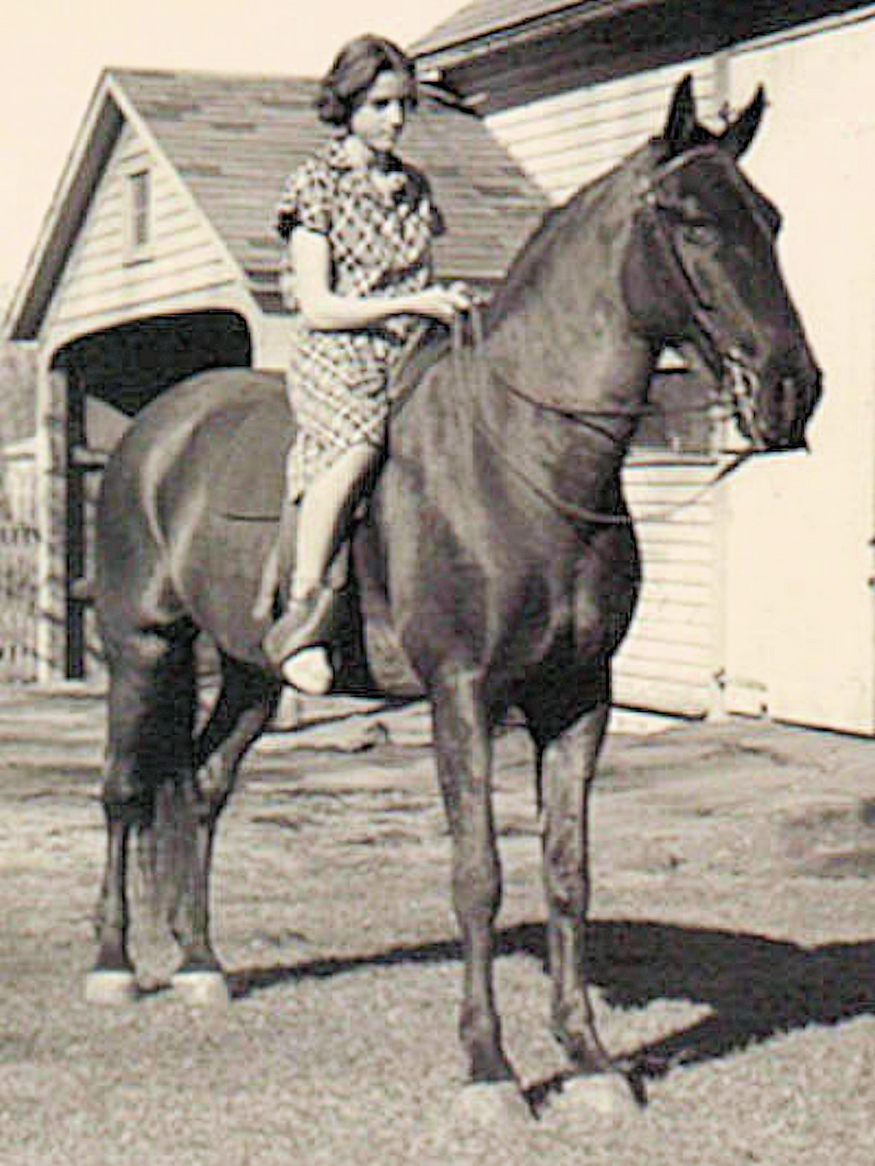
 Lena Putnam's daughter Dolores on Trigger
Lena Putnam's daughter Dolores on Trigger
TRIGGER, LADY & THE SOUTHWICK PLACE
Some time about 1930 Thomas à Kempis disappeared from the Woodward records. When Thomas à Kempis died, his replacement, Trigger, took over and apparently was as knowledgeable and agreeable as was Thomas à Kempis. Trigger's given name prior to Woodward acquiring him was Nigger for its solid, jet black coat, but, even in those not-so-politically-correct days, Woodward appropiately changed it to Trigger and the horse never seemed to notice the difference. It was Trigger who later, in 1934, moved up to the Southwick Studio Barn after the disastrous lightning-caused fire which destroyed the Hiram Woodward home and studio.
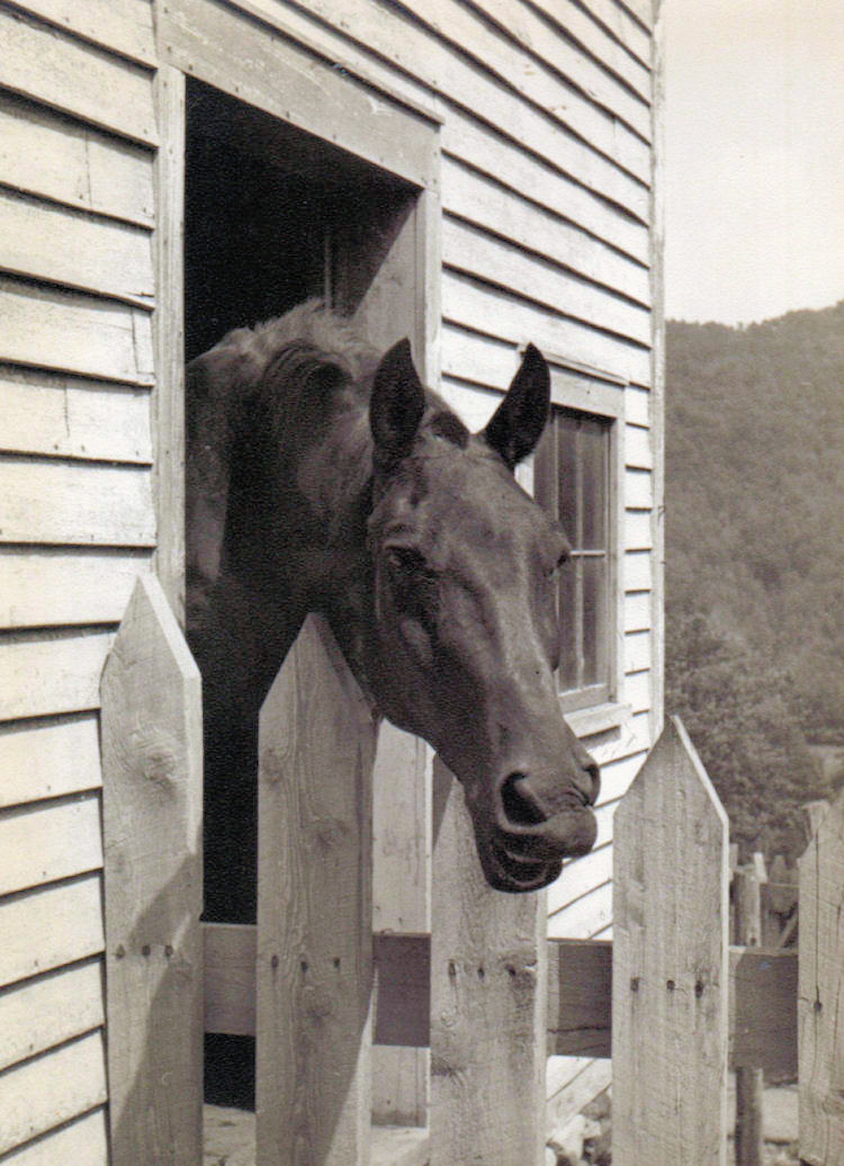
 Trigger peaking his head out his stall at
Trigger peaking his head out his stall at
Southwick's side barn door. Photo by:
Woodward friend F. Earl Williams.
And it was Trigger who was the Horse of the Southwick Barn during my days of working for RSW. I frequently rode him, drove him in
a sleigh and in a buggy, and fed, groomed and mucked him out daily. (FOR MORE: read about a recollection of my Christmas time sleigh ride - MLP).
He was so well-mannered that even the neighborhood
children rode horseback on him (see picture below of the young boy Phillip on Trigger).
Trigger got old and his teeth deteriorated so badly that he could not masticate his hay. One day he was taken away by Ray Stone, Fabian's brother. The story is told that Ray led Trigger, now much thinner, on a short rope to his halter, from his barn. They slowly went down Upper Street. Ray returned to work several days later. No one ever knew what happened to Trigger or where he went. This happened while I was away at college. Nothing more was said. I did not want to know anything more.
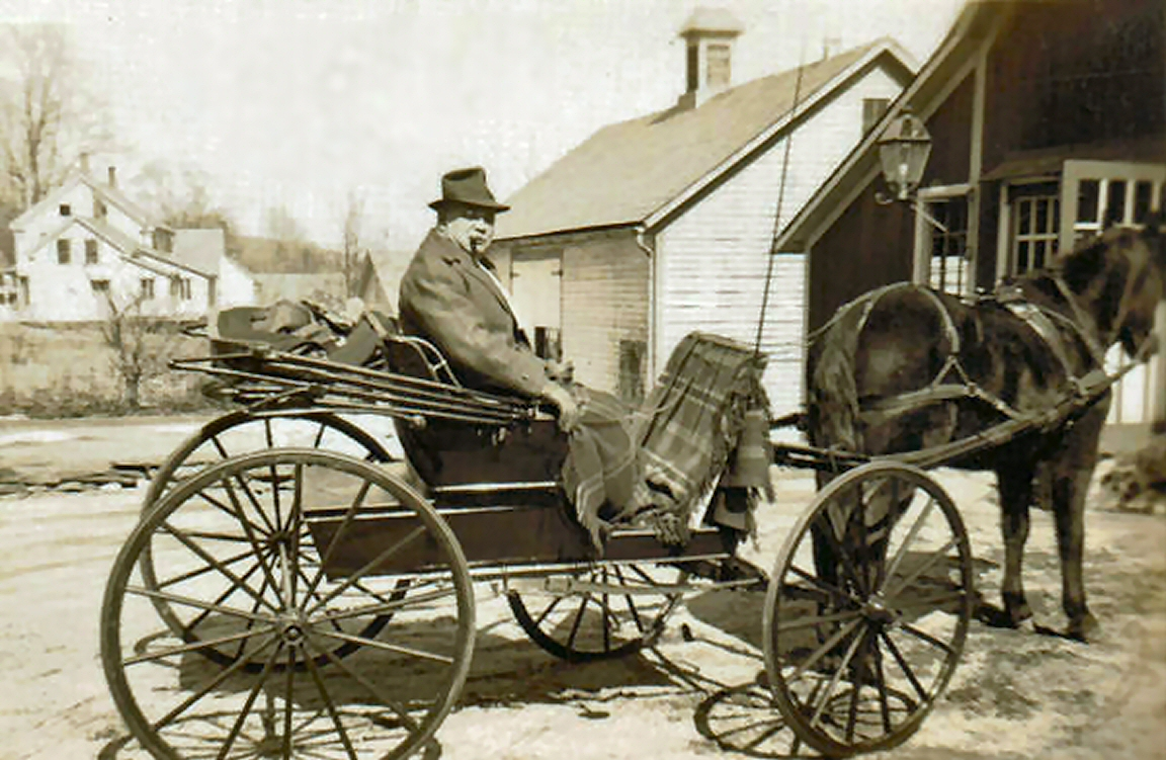
 Trigger & RSW in 1942 still going for buggy ride
Trigger & RSW in 1942 still going for buggy ride
At this point, dear reader, may I ask for a paragraph aside. Horses and humans do not live parallel life spans. The average horse in the 1940-50s lived about 15 years and the average human about 70. Those of us who are "into" horses must consequently expect to have several different horses during our lifetimes. Old horses in the wild, because they outlive their teeth, usually die slowly of starvation. This is mentioned in several of the old cowboy movies where a cowboy had to "put down" his horse with his Colt .45 to prevent this from happening. We as humans, these days, must accept the fact that rather than starving, there is a more compassionate death for a horse at the rendering plant. And then we must get on with things. This is a life truth taught me by Robert Strong Woodward.
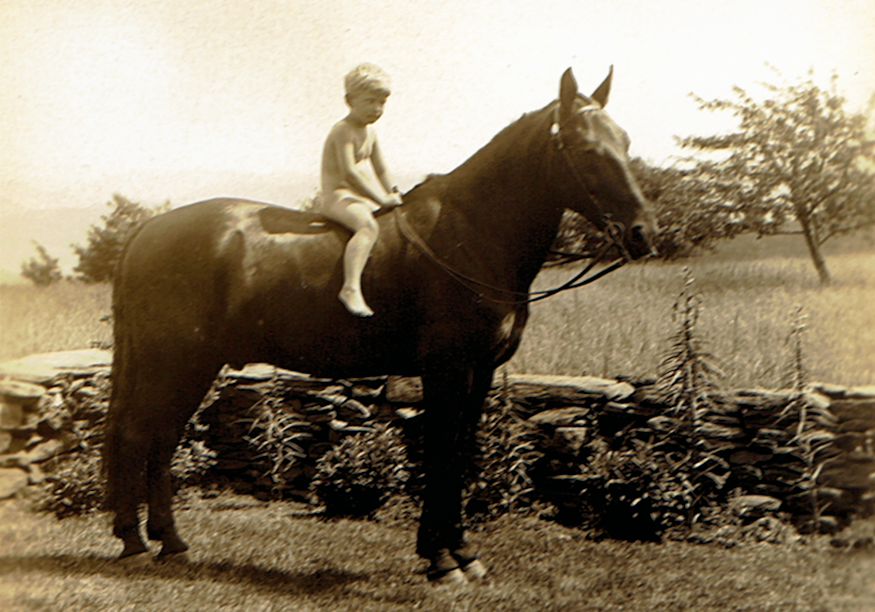
 A young boy, Phillip, sitting on Trigger for
A young boy, Phillip, sitting on Trigger for
a picture at the Tripp's place in Heath.
----------------------------------------------------
We have come to learn through local newspaper
gossip that RSW and his friends often rented
or swapped houses regularly through the years.
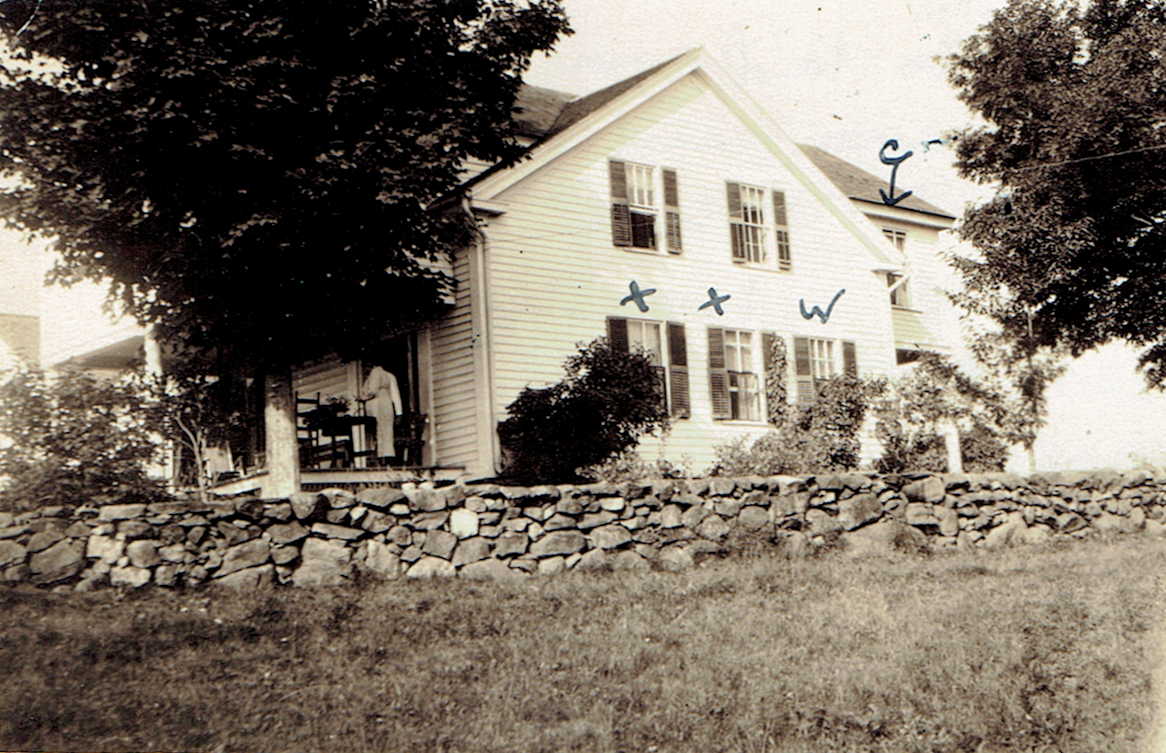
 A photograph taken sometime between 1933
A photograph taken sometime between 1933
and '36 of RSW's close friends, the Tripps, sum-
mer home in Heath. RSW would stay there from
time to time prior to purchasing the adjacent
Burnt Hill pasture. RSW would sleep either on
the rear side porch below the arrow pointing
to the guest bedroom he used.
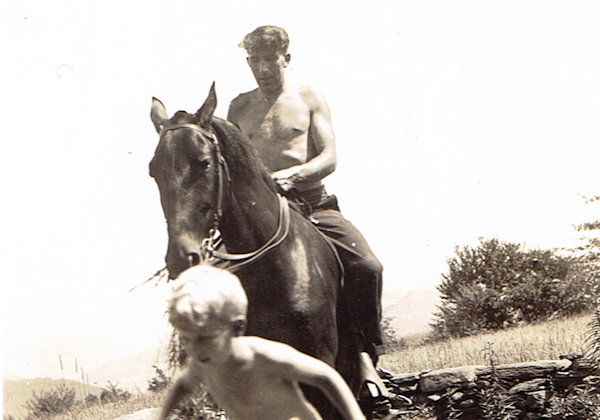
 Fabian on Trigger with Phillip in the fore-
Fabian on Trigger with Phillip in the fore-
ground at the Tripp's place in Heath.
----------------------------------------------------
The Tripp's lived in Rye, NY, as their primary resid-
ence. RSW would care and tend to their Heath
home and they hosted him when he visited NYC.
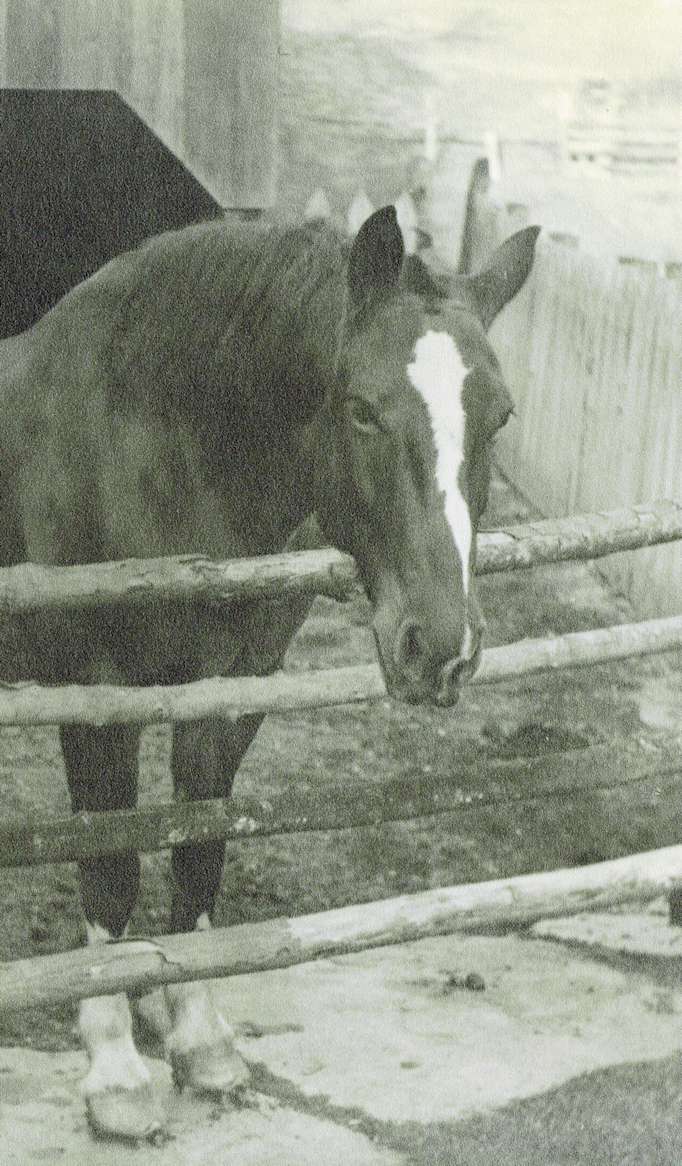
 Lady in coral at Southwick
Lady in coral at Southwick
The next and last horse to appear in the Southwick Barn was Lady. She was Horse of the Barn during the years I was away in medical school. By this time RSW was not as physically strong as he was in his younger days, and he was no longer able to harness up and drive Lady. I do not remember her ever drawing the sleigh or buggy. But Lady did make herself useful around the farm.
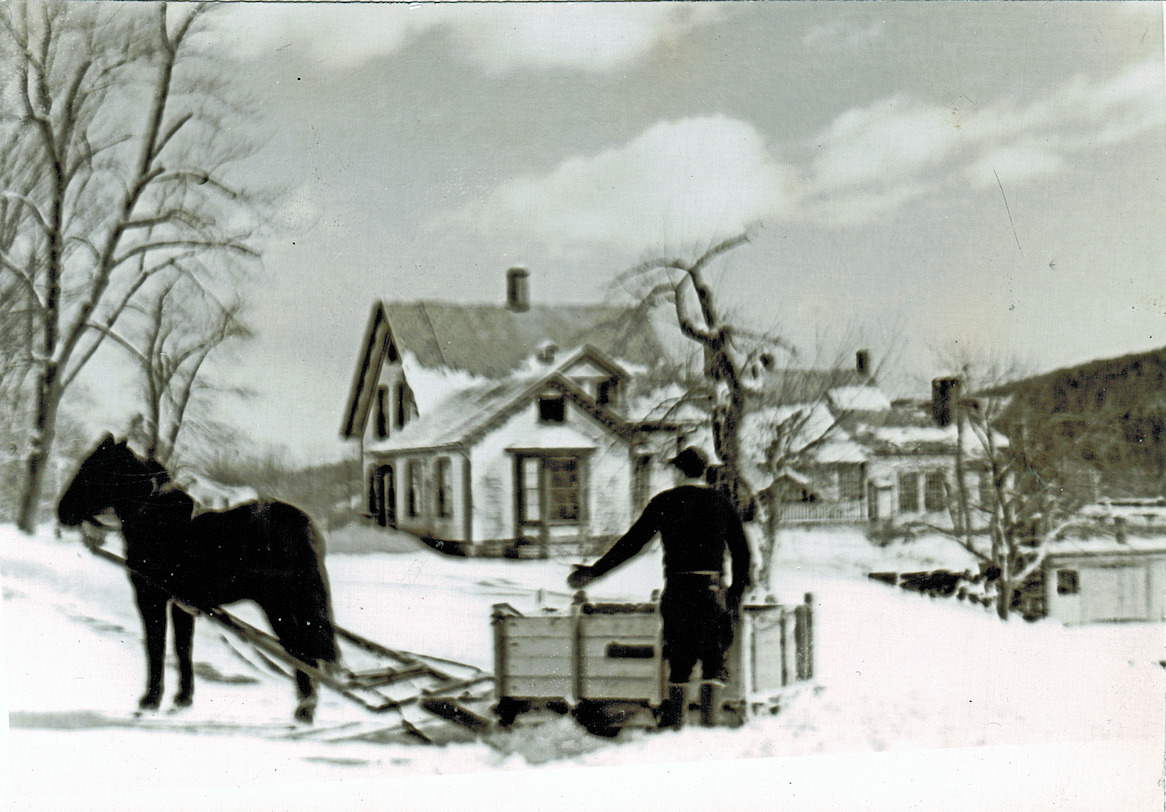
 A photograph of Lady pulling the shed to remove snow.
A photograph of Lady pulling the shed to remove snow.
The man with his back to the camera is unknown.
Her main responsibility was in the winter time. She dragged a sled full of snow shoveled off from the driveway, and
dumped it into the orchard hollow. Trigger, trained by Fabian Stone, had initiated this "trick" and it was amazing to watch.
Before the days of snow blowers the RSW driveways were
always hand-shoveled clean of snow, and the snow thrown into a large sled. This was then dragged over to the nearby orchard hollow and backed up over the sidewalk until it tilted perilously over
the edge. When the balance was just right, Trigger, then later Lady, would lunge forward, jerking the sled so that the snow would slide off the sled into the hollow. Neighbors passing by often stopped
to watch.
Even though I did not know Lady nearly as well as I knew and loved Trigger, I did not want to learn about the end of her life either. She was not in the Southwick Barn at the time Uncle Rob died on June 26, 1957.
ADDENDUMS TO THE TRIGGER & LADY SECTION:
 Just for some context to the comings and
goings of Dr. Mark while in the employ of Woodward... Mark began working for RSW in 1940 at 14 years old. He began to drive for RSW when he turned sixteen.
Just for some context to the comings and
goings of Dr. Mark while in the employ of Woodward... Mark began working for RSW in 1940 at 14 years old. He began to drive for RSW when he turned sixteen.
 In 1944, Mark graduated high school and left to serve in the U.S. Army Air Corps nearing the end of World War II, returning in 1946 to work the summer
before heading to college.
In 1944, Mark graduated high school and left to serve in the U.S. Army Air Corps nearing the end of World War II, returning in 1946 to work the summer
before heading to college.
 He attended Oberlein College in Ohio from the fall of 1946 to his graduation in May of 1950. He returned each summer to work and drive for RSW.
He attended Oberlein College in Ohio from the fall of 1946 to his graduation in May of 1950. He returned each summer to work and drive for RSW.
 Mark worked the summer of 1950 for RSW. In August Mark married Barbara and the two moved to Boston for the start of Mark attending medical
school at Tufts University Medical School.
Mark worked the summer of 1950 for RSW. In August Mark married Barbara and the two moved to Boston for the start of Mark attending medical
school at Tufts University Medical School.
 That summer of 1950 would be the last year Mark would work for RSW. He visited home and RSW as often as he could and kept in touch through
letters and phone calls. Woodward died June 24, 1957 leaving the bulk of his estate to Mark who was now living in Waterbury, CT finishing his surgical residency at Waterbury Hospital.
That summer of 1950 would be the last year Mark would work for RSW. He visited home and RSW as often as he could and kept in touch through
letters and phone calls. Woodward died June 24, 1957 leaving the bulk of his estate to Mark who was now living in Waterbury, CT finishing his surgical residency at Waterbury Hospital.
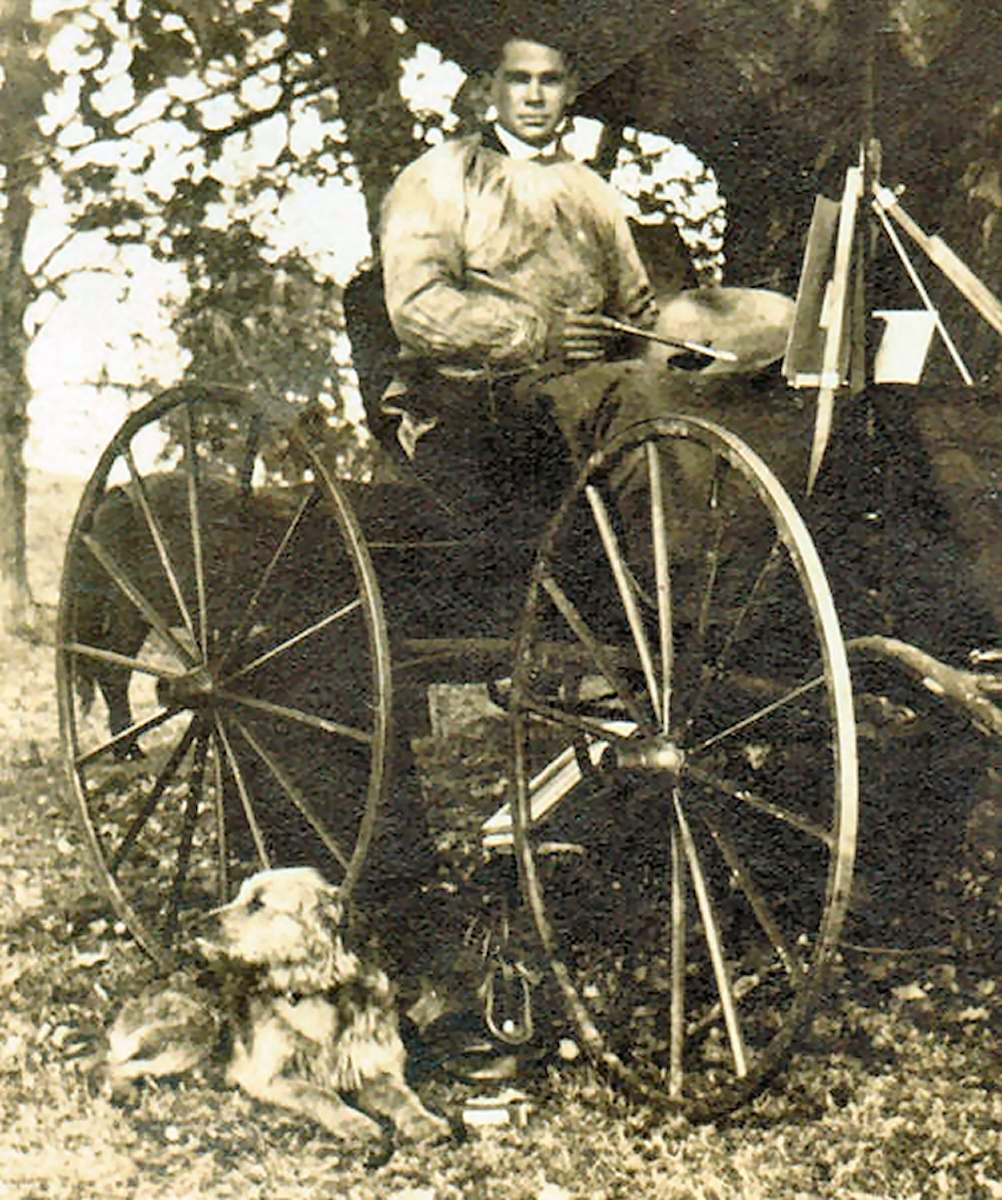
 Woodward in a smock, on his buggy with his dog Patrick
Woodward in a smock, on his buggy with his dog Patrick
WOODWARD'S DOGS
Enough of the story of the horses. RSW also loved dogs. We know of at least three dogs who were Friends of Robert Strong Woodward. In the old photographs from the days of Redgate there are some pictures of RSW in his buggy with a dog comfortably lying beside one of the wheels. This was Patrick, an Irish Setter. His name was often mentioned in the RSW diaries as having been with him when a certain painting was made.
When RSW first came to the Southwick Studio he owned two Irish Setters, Sean and Terry. Abbie Labelle well remembers these two dogs sitting one on either side of his wheelchair. (To read her story which tells about these dogs click here) By the time of my beginning to work at the Woodward place both dogs had died. There remained only their doghouse which was built into the back side of the studio building near the rain barrel. It was thoroughly insulated. It still remains as a part of the building.
Yes, indeed, RSW loved his horses, and he loved his dogs. He was kind to all of them. Also, the ones I
personally knew loved him as well.
MLP, July 2013
BCM, August 2020
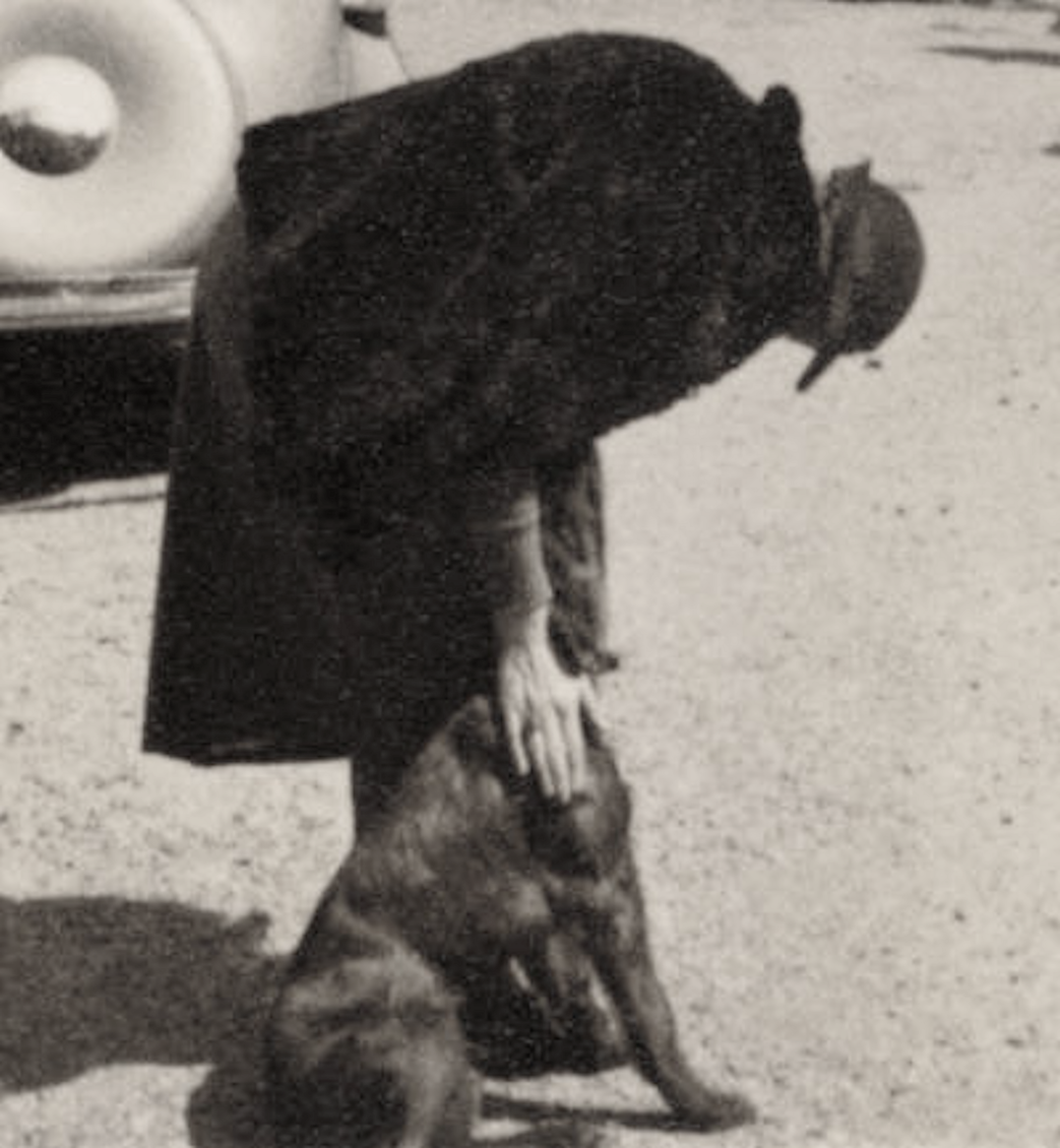
ABOVE: A Woodward guest greeting the dog

BELOW: The swinging doggie-door behind and under
the carriage house Woodward added for his dogs.

ADDENDUMS TO THE THOMAS À KEMPIS SECTION:
 We do not have all of the names or how many dogs RSW had in his life time. We have no knowledge of him ever mentioning a cat. It seems unlikely though that
there was never a cat given how apt they are at catching mice. But dogs are different than cats, right? Cats tend to be aloof and indifferent at times. Much more independent than dogs which make great,
loving companions and pals always happy to see you.
We do not have all of the names or how many dogs RSW had in his life time. We have no knowledge of him ever mentioning a cat. It seems unlikely though that
there was never a cat given how apt they are at catching mice. But dogs are different than cats, right? Cats tend to be aloof and indifferent at times. Much more independent than dogs which make great,
loving companions and pals always happy to see you.
 It seems that RSW had a preference for Irish Setters. It is not easy to tell but my first impression of Patrick (above) is that he is an Irish Setter, given
the very Irish names also given to Sean and Terry. From Wikipedia regarding Irish Setters, "The Irish Setter is a setter, a breed of gundog, and family dog. The term Irish Setter is commonly used to
encompass the show-bred dog recognised by the American Kennel Club as well as the field-bred Red Setter recognised by the Field Dog Stud Book... Temperament: Affectionate, Energetic, Lively,
Independent, Playful, Companionable"
It seems that RSW had a preference for Irish Setters. It is not easy to tell but my first impression of Patrick (above) is that he is an Irish Setter, given
the very Irish names also given to Sean and Terry. From Wikipedia regarding Irish Setters, "The Irish Setter is a setter, a breed of gundog, and family dog. The term Irish Setter is commonly used to
encompass the show-bred dog recognised by the American Kennel Club as well as the field-bred Red Setter recognised by the Field Dog Stud Book... Temperament: Affectionate, Energetic, Lively,
Independent, Playful, Companionable"
 Animals, especially house pets, were often included in a number of paintings by Woodward. Cats are featured prominently in
The Genial Old House and A Country Interior. Dogs in Contentment
and The Tufts' Living Room. Both a cat and dog appear in one of Woodward's
Passing New England. It is hard to see but the dog is laying at the feet of the man leaning back in his chair inside his garage. The cat is in the yard on the lower right of the painting. The significance of this
painting cannot be understated. It was painted during the height of the Great Depression and was invited to exhibit at the 1936 Art Institute of Chicago's annual exhibition. They seem to represent the peace and
comfort of home during trying times.
Animals, especially house pets, were often included in a number of paintings by Woodward. Cats are featured prominently in
The Genial Old House and A Country Interior. Dogs in Contentment
and The Tufts' Living Room. Both a cat and dog appear in one of Woodward's
Passing New England. It is hard to see but the dog is laying at the feet of the man leaning back in his chair inside his garage. The cat is in the yard on the lower right of the painting. The significance of this
painting cannot be understated. It was painted during the height of the Great Depression and was invited to exhibit at the 1936 Art Institute of Chicago's annual exhibition. They seem to represent the peace and
comfort of home during trying times.
 Not mentioned in Dr. Mark's essay is the fact Woodward did have chickens. This was not uncommon for the period but it is worth noting since they do not appear in
any pictures. The coop was built into the new addition to the barn during the Southwick renovation as the old Taylor coop was detached from the barn
prior to it being moved to the other side of the house and studio. The old coop was placed behind the original house and coverted into a room to help run the ramp from the back of the house to the studio.
Not mentioned in Dr. Mark's essay is the fact Woodward did have chickens. This was not uncommon for the period but it is worth noting since they do not appear in
any pictures. The coop was built into the new addition to the barn during the Southwick renovation as the old Taylor coop was detached from the barn
prior to it being moved to the other side of the house and studio. The old coop was placed behind the original house and coverted into a room to help run the ramp from the back of the house to the studio.
Though not pets chickens represent a vital facet to country life and chickens appear in quite a few paintings throughout his career, as well as, cows which RSW did not own.
For more see: PEOPLE & LIVESTOCK GALLERY
PAINTINGS WITH CATS & DOGS
PAINTINGS WITH HORSES
RELATED INTEREST & LINKS
SCAPBOOK PAGE

